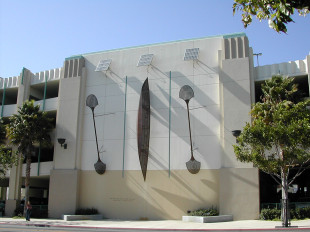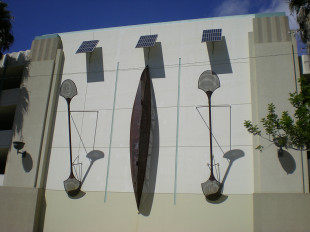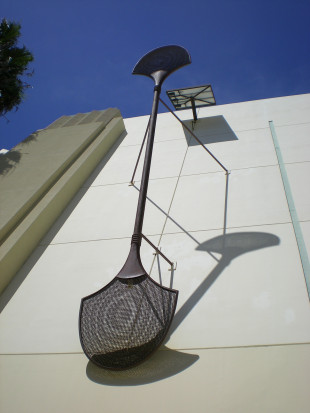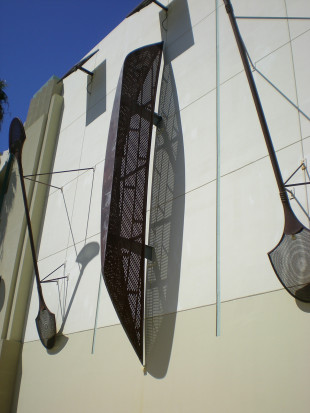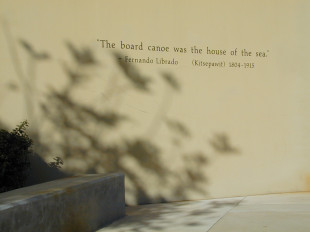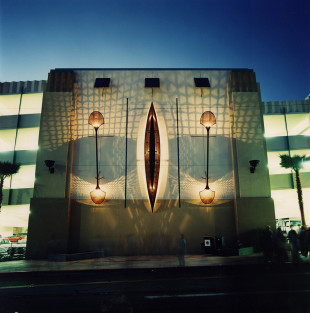- 01
- 02
- 03
- 04
- 05
- 06
Traveller
Image list
- Traveller (1998) – installation view
Steel, halogen lamps, solar photovoltaic panels, engraved concrete
Paddle sculptures: each 22’ x 4’ x 1’; Canoe sculpture: 30’ x 4’ x 3’ - Traveller (1998) – detail of installation
Steel, halogen lamps, solar photovoltaic panels
Paddle sculptures: each 22’ x 4’ x 1’; Canoe sculpture: 30’ x 4’ x 3’ - Traveller (1998) – detail of installation: Paddle
Steel, halogen lamps; 22’ x 4’ 1’ - Traveller (1998) – detail of installation
Steel, halogen lamps, solar photovoltaic panels
Paddle sculptures: each 22’ x 4’ x 1’; Canoe sculpture: 30’ x 4’ x 3’ - Traveller (1998) – detail of installation
Engraved concrete; text approx. 9” x 9’ - Traveller (1998) – installation view
Steel, halogen lamps, solar photovoltaic panels, engraved concrete
Paddle sculptures: each 22’ x 4’ x 1’; Canoe sculpture: 30’ x 4’ x 3’
Info
Artist Team: Blue McRight, Lead artist; Warren Wagner, architect
Project Title: Traveller
Date Completed: 1998
Commissioned by: The City of San Buenaventura Public Art Program
Project Location: Downtown Parking Structure
555 E. Santa Clara Street, Ventura, CaliforniaTraveller is a site-specific, environmental work of public art inspired by the history and program of its site. Of particular interest to us was the well-established Chumash village, Shishilop, at what is now Ventura, where the Brotherhood of the Canoe made the unique board canoes that enabled their culture to flourish. The artwork makes connections between that era and our contemporary one at a structure designed to accommodate the automobile, our culture’s favored mode of transportation.Consisting of two groups of steel light sculptures, the project is installed in two locations. On the main entrance’s south-facing shear wall at Santa Clara Street, there are three sculptures and on the Paseo side, two smaller sculptures on the pedestrian landing mark that entry.Traveller presents different aspects by day and by night, casting shadows and projecting patterns of light onto adjacent surfaces of the Parking Structure, thereby incorporating the building as part of the art. All of the lanterns are illuminated by solar electricity, generated during the day via photovoltaic panels mounted high on the Santa Clara Street wall. Besides powering the artwork, the solar panels are featured artwork elements: contemporary symbols of the sun.Fernando Librado, who built the last Chumash canoe, became the oral historian of the local tribe when he was extensively interviewed as a very old man. His words are engraved in the concrete wall below the light sculptures:
Project Title: Traveller
Date Completed: 1998
Commissioned by: The City of San Buenaventura Public Art Program
Project Location: Downtown Parking Structure
555 E. Santa Clara Street, Ventura, CaliforniaTraveller is a site-specific, environmental work of public art inspired by the history and program of its site. Of particular interest to us was the well-established Chumash village, Shishilop, at what is now Ventura, where the Brotherhood of the Canoe made the unique board canoes that enabled their culture to flourish. The artwork makes connections between that era and our contemporary one at a structure designed to accommodate the automobile, our culture’s favored mode of transportation.Consisting of two groups of steel light sculptures, the project is installed in two locations. On the main entrance’s south-facing shear wall at Santa Clara Street, there are three sculptures and on the Paseo side, two smaller sculptures on the pedestrian landing mark that entry.Traveller presents different aspects by day and by night, casting shadows and projecting patterns of light onto adjacent surfaces of the Parking Structure, thereby incorporating the building as part of the art. All of the lanterns are illuminated by solar electricity, generated during the day via photovoltaic panels mounted high on the Santa Clara Street wall. Besides powering the artwork, the solar panels are featured artwork elements: contemporary symbols of the sun.Fernando Librado, who built the last Chumash canoe, became the oral historian of the local tribe when he was extensively interviewed as a very old man. His words are engraved in the concrete wall below the light sculptures:
“The board canoe is the house of the sea”.
